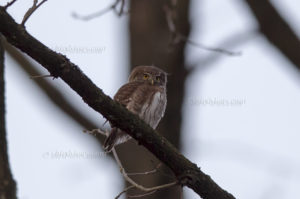 Wintertime is the best time to detect owls. And the Eurasian Pygmy-Owl (Glaucidium passerinum) is no exception to that pattern. The Rochauer Heide, an area of dense oak and pine forest some 60 km south of Berlin, lies in a monotonous peace in the wintry twilight. The oaks are bare and the pines and spruces give with their green the only change in the gray-brown of the forest. Then – about 5:30 p.m. – on this February evening, the monotonous, high-pitched call of the Eurasian Pygmy-Owl can be heard from a dense forest patch; not far from the well-developed dirt road. The slight east wind of the day has subsided; it is getting colder now at dusk. It should be around 0 ° C. Then even a second calling owl comes in. A second male feels addressed and also calls, but in a different, different pitch. First, the second caller is heard at a distance. But this Eurasian Pygmy-Owl feels provoked, flies along the forest path and finally sits right next to its rival. My location seems to be near the territorial border of the two male Eurasian Pygmy-Owls. Their encounter seems so shocking that both Eurasian Pygmy-Owls are now silent. The rival flies away again. Its silhouette is beautiful to be seen in front of the cloudless sky. Now the first – probably the territory owner – begins to sing in a higher pitch while the second Eurasian Pygmy-Owl male responds with a lower pitch song from the south. A little later, both males sit close to each other again and sing in duet. The second male then deviates in a southerly direction and is followed by the first male.
Wintertime is the best time to detect owls. And the Eurasian Pygmy-Owl (Glaucidium passerinum) is no exception to that pattern. The Rochauer Heide, an area of dense oak and pine forest some 60 km south of Berlin, lies in a monotonous peace in the wintry twilight. The oaks are bare and the pines and spruces give with their green the only change in the gray-brown of the forest. Then – about 5:30 p.m. – on this February evening, the monotonous, high-pitched call of the Eurasian Pygmy-Owl can be heard from a dense forest patch; not far from the well-developed dirt road. The slight east wind of the day has subsided; it is getting colder now at dusk. It should be around 0 ° C. Then even a second calling owl comes in. A second male feels addressed and also calls, but in a different, different pitch. First, the second caller is heard at a distance. But this Eurasian Pygmy-Owl feels provoked, flies along the forest path and finally sits right next to its rival. My location seems to be near the territorial border of the two male Eurasian Pygmy-Owls. Their encounter seems so shocking that both Eurasian Pygmy-Owls are now silent. The rival flies away again. Its silhouette is beautiful to be seen in front of the cloudless sky. Now the first – probably the territory owner – begins to sing in a higher pitch while the second Eurasian Pygmy-Owl male responds with a lower pitch song from the south. A little later, both males sit close to each other again and sing in duet. The second male then deviates in a southerly direction and is followed by the first male.
At around 6:15 p.m. the excitement has settled. Both Pygmy-Owls have moved further into the forest. One of the males, however, continues to be heard singing. Even a calling Tawny Owl (Strix aluco) cannot stop the singing. But the Tawny Owl is still far away.
The well-described classic habitat scheme of Pygmy Owl is similar to that of coniferous forests. Mostly, the Rochauer Heide does not match this. Rather, it is characterized by mosaic-like pattern of coniferous and deciduous forest.
This (southern) part of the Rochauer Heide is part of a nature reserve in the district of Dahme-Spreewald. It is a large coherent forest complex. Much of the forest is made up of pine plantations (Pinus sp.), which are increasingly loosened up with a Sessile Oak (Quercus petraea or Quercus sessilis) undergrowth. Light pine forests provide the conditions for a rich occurrence of blueberry. This grows in some places like a thick, dense carpet. In some places there is still a core forest made of the original pine-grape oak areas. These correspond to the natural vegetation of the back of the country. Again and again you can see departments with many, old trees. There is another representative of the owls in the area. It is the Boreal Owl (Aegolius funereus). The Boreal Owl is even the heraldic animal of the nature park in which the Rochauer Heide lies. He has his most permanent occurrence here in Brandenburg. The Boreal Owl is strictly nocturnal. With a little luck you can hear him in late winter with his typical calls. At the time of the visit it was probably too early.
To cope with the growing demand for top shots of the rarer species of the Palearctic Bird-Lens is keen to enrich the range of pictures of birds you can find in the western palearctic. Trips to remote places like this one to capture images not only of rare birds of western palearctic were very successful. The nice image of the blog is only a first impression, what you will find in the gallery in the “Picture Shop” very soon. Just give bird-lens.com a message, if bird-lens.com could serve you with an image needed before the new pictures are online.